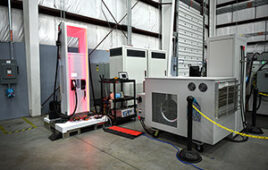$4.3 million DARPA grant enables development of biological and chemical threat detector
 |
||||
A new class of sensors able to detect multiple biological and chemical threats simultaneously with unprecedented performance may soon be within reach thanks to the establishment of a multi-million dollar research center led by Georgia Institute of Technology engineers.
Biological and chemical sensing are active research areas because of their applications in clinical screening, drug discovery, food safety, environmental monitoring and homeland security. Using integrated photonics, the new class of sensors will be capable of detecting chemical agents — such as toxins, pollutants and trace gases — and biological agents — such as proteins, viruses and antibodies — simultaneously on the same chip.
“The proposed sensors will detect multiple biological and chemical threats on a compact integrated platform faster, less expensively and more sensitively than the current state-of-the-art sensors,” said the center’s leader Ali Adibi, a professor in the School of Electrical and Computer Engineering at Georgia Tech.
The Defense Advanced Research Projects Agency (DARPA) is funding the two-year $4.3 million center as one of its Centers in Integrated Photonics Engineering Research (CIPhER), which investigate innovative approaches that enable revolutionary advances in science, devices or systems. For its center, Georgia Tech is working with researchers from Emory University; Massachusetts Institute of Technology; University of California, Santa Cruz; and Yale University. The team also includes industry collaborators Rockwell Collins, Kotura, Santur Corporation and NanoRods.
 |
||||
To create an integrated chip that will simultaneously detect multiple biological and chemical agents, the researchers need to achieve three major goals:
- Design and fabricate photonic and optomechanical structures to sense differences in a sample’s refractive index, Raman emission, fluorescence, absorption and mass;
- Functionalize the sensor surface with coatings that chemical and biological agents will attach to and create differences that can be detected; and
- Develop the sample preparation method and microfluidic sample delivery device, and connect the device to the coated photonic structure.
Adibi is leading the first thrust, which is primarily focused on fabricating the millimeter-square sensing structures and on-chip spectrometers that will enable multiplexing — the detection of multiple agents using the same sensing modules. The sensors will detect changes in the refractive index, Raman emission, fluorescence, absorption spectra and optomechanical properties when a sample that includes specific biological or chemical particles interacts with the sensor coatings. Combining information obtained from the five different sensing modalities will maximize the sensor specificity and minimize its false detection rate, the researchers say.
“The goal is to achieve very high sensitivity for each modality and investigate the advantages of each modality for different classes of biological and chemical agents in order to develop a clear set of guidelines for combining different modalities to achieve the desired performance for a specific set of agents,” explained Adibi.
Massachusetts Institute of Technology chemistry professor Timothy Swager is leading the second part of this project, which aims to design surface coatings that will achieve maximum sensor specificity in detecting multiple biological and chemical agents.
“We plan to develop glycan-based surface coatings to sense biological agents and polymer-based surface coatings to sense chemical agents,” noted Adibi.
For the third thrust, which is being led by Massachusetts Institute of Technology electrical engineering associate professor Jongyoon Han, the researchers will develop optimal sample preparation and delivery techniques. Their goal is to maximize the biological or chemical particle concentration in the sample and limit detection time to minutes.
“In two years, we hope to have a lab-on-a-chip system that includes all of the sensing modalities with appropriate coatings and microfluidic delivery,” said Adibi. “To show the feasibility of the technology, we plan to demonstrate the high sensitivity and high selectivity of each sensor individually and be able to use at least two of the sensing modalities simultaneously to detect two or three different chemical or biological agents.”
In addition to those already mentioned, this center also includes Georgia Tech chemistry and biochemistry professor Mostafa El-Sayed, Georgia Tech materials science and engineering professor Kenneth Sandhage, Georgia Tech Nanotechnology Research Center senior research scientist David Gottfried, Emory University biochemistry chair Richard Cummings, University of California Santa Cruz electrical engineering professor Holger Schmidt, and Yale University electrical engineering associate professor Hong Tang.




